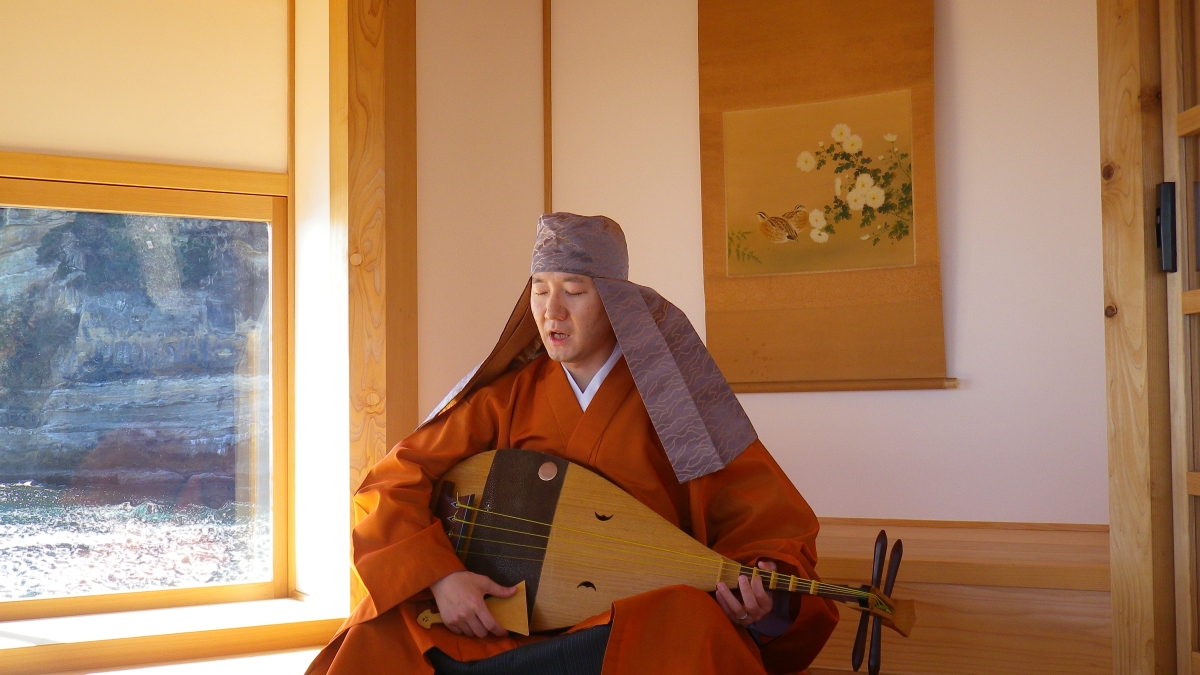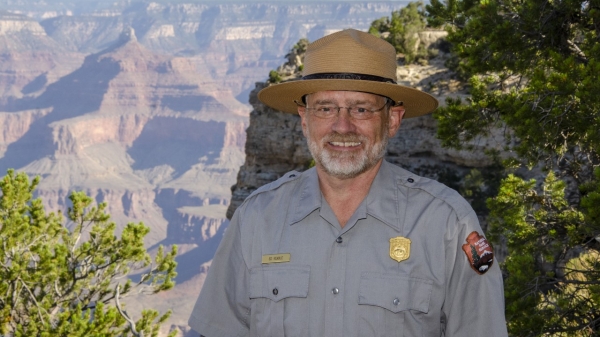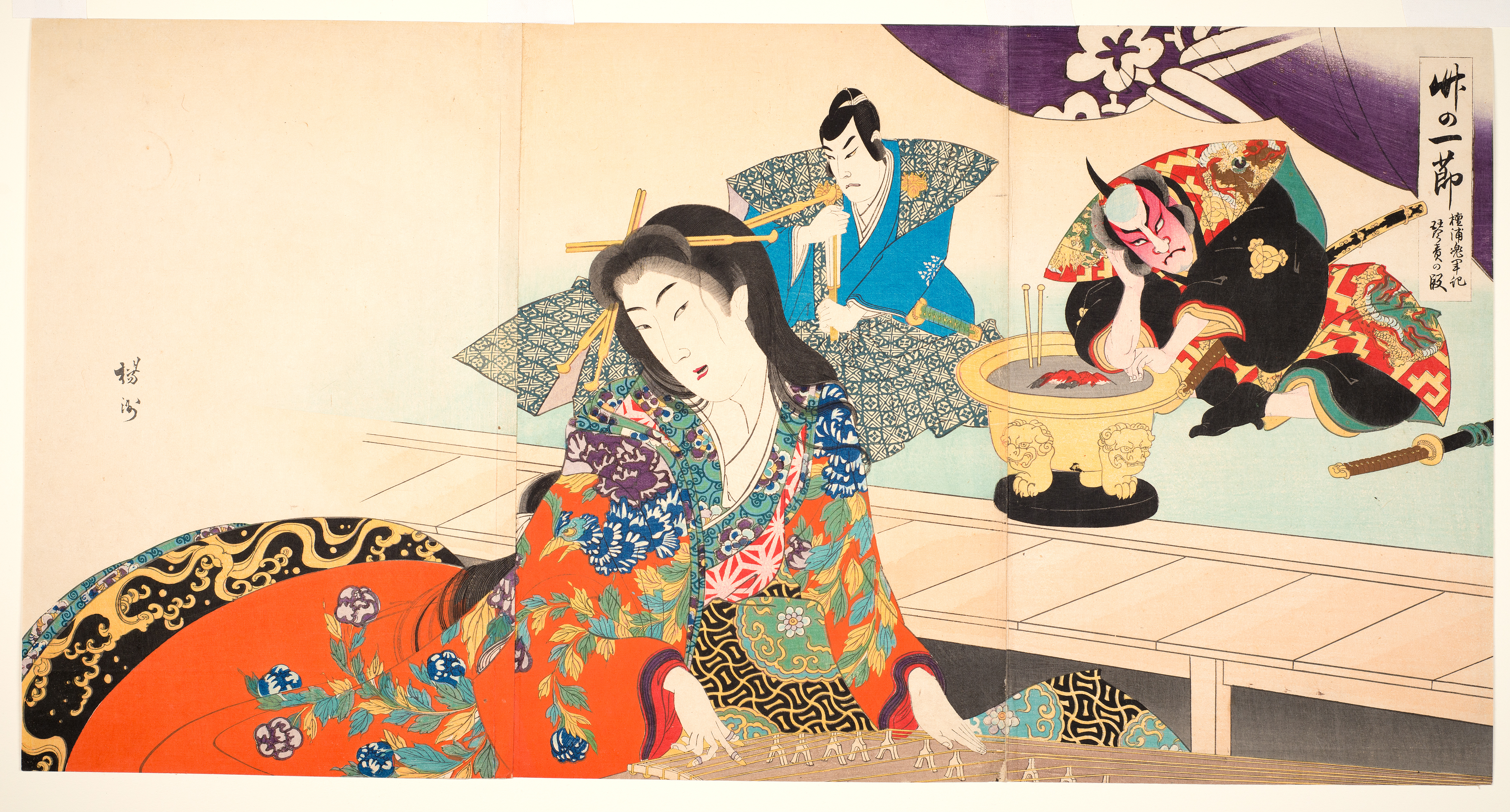Japanese troubadour to perform in Arizona as part of music and art series

Tsutomu Arao performs Gion Shōja from "The Tale of the Heike" on Feb. 24, 2013, at Rokkakudō, Izura, Kita-Ibaraki City.
Japanese performer Tsutomu Arao will present a musical program of "The Tale of the Heike" at Arizona State University’s Katzin Concert Hall on Sept. 24. His performance of musical storytelling with the accompaniment of the biwa (lute) is part of a larger program of events that includes a display of Japanese prints relating to "The Tale of the Heike" from the Frank Lloyd Wright Collection at Taliesin West together with prints from the ASU Art Museum collection. These will be available for viewing by appointment in the Jules Heller Print Study Room of the ASU Art Museum. These prints, all from the 19th century, illustrate characters and episodes from "The Tale of the Heike" and related literature and theater, and many feature verses by famous poets alluding to related stories.
"The Tale of the Heike" is the greatest of all Japanese warrior tales and one of the seminal works that have shaped Japanese literature, theater, art and film down to the present day. The Heike were the most powerful clan in the late 12th century and had close ties to the Imperial Court. The story is about the battle between the Heike and another powerful clan, the Genji, and it ends with the total defeat of the Heike in the tragic sea battle at Dan-no-ura. Wandering troubadours, blind musicians, chanted the tale, and later poets and playwrights took inspiration from it.
Tsutomu Arao plays the biwa (a lute that originated in Persia or Central Asia, much like the Chinese pipa) while singing"The Tale of the Heike." He is one of the very few people who can recite the whole story in the original style from the 13th century, and he has established a school to preserve this style for the future.
He is also a special lecturer at Keio University, one of the oldest and most prestigious private universities in Tokyo. By the end of 2016, he had performed Heikyoku more than 900 times. His most recent performance outside of Japan was at the Tchaikovsky State Conservatory in 2016, when he was one of the invitees from many countries around the world. This will be the first performance in the United States of this style of Heikyoku. In modern Japan, many biwa performers rely on rapid, dramatic strumming of chords. Arao, however, preserves the original heikyoku emphasis on vocal performance, which relies on a variety of traditional modes of narration and song, often punctuated by short, single-string phrases from the biwa, to express the changing drama of the tale. While in Arizona, Arao will also perform at the University of Arizona and Northern Arizona University.
The American architect Frank Lloyd Wright became interested in Japanese art in the 1890s, and in 1905 he traveled to Japan. From that time to his late years spent at Taliesin West in Scottsdale, he maintained his collecting and studying of Japanese prints. Prints that he once owned are in major art museums around the United States. Taliesin West holds his collection of surimono, the privately printed Japanese prints commissioned by poetry societies in the early 19th century. A selection of surimono relating to "The Tale of the Heike" will be lent to ASU Art Museum for several weeks so that ASU students and faculty and members of the community can view them. ASU Art Museum will make its collection of ukiyo-e prints relating to "The Tale of the Heike" vailable for viewing as well. One of Arao’s Arizona performances will be held at Taliesin West.
Colin Pearson, curator for Asia, Oceania and the Middle East at the Musical Instrument Museum, will speak on the origin and development of the biwa in the Recital Hall of the ASU School of Music on Sept. 21. Pearson holds a master of arts degree in ethnomusicology from the University of California, Riverside, specializing in the music of Thailand, Cambodia and immigrant communities. One of his current projects involves the musical instruments of Japan.
Toyohara Chikanobu, "Chronicle of the Dan-no-ura Helmet: Torturing a captive courtesan, Akoya, by making her play the koto" (a Japanese musical instrument), dated 1898, woodblock print, ASU Art Museum, gift of Thomas and Martha Carter.
The series is organized by ASU’s Center for Asian Research and supported by several other units at ASU, including the Emeritus College; the Office of Vice President Christine Wilkinson; ASU Art Museum; ASU Library; the School of Historical, Philosophical and Religious Studies; the School of Music, Barrett, The Honors College; and the art history faculty of the School of Art. Additional sponsorship is provided by the Department of East Asian Studies, University of Arizona, and the Asian Studies program, Northern Arizona University. Funding has also come from the Japanese Culture Club of Arizona and more than 10 individual donors.
All events are free and open to the public.
'Eight Hundred Years of Tradition: "The Tale of the Heike" in Music and Woodblock Prints'
Fall 2018, Japanese surimono prints from the Frank Lloyd Wright Collection at Taliesin West, viewing available by appointment in the Jules Heller Print Study Room of the ASU Art Museum. Japanese ukiyo-e prints from the ASU Art Museum collection will also be shown. Contact Claudia Brown (claudia.brown@asu.edu) for more information.
'Popular Heroes: An Album of Japanese Print Triptychs'
Sept. 14, 10:45-11:30 a.m.; ASU Design and the Arts Library
Collector Darlene Goto, connoisseur Laurie Petrie-Rogers and scholar Sarah Gossett
'Silk Strings and Crescent Moons: The Story of the Japanese Biwa'
Sept. 21, 10:45-11:30 a.m.; Recital Hall, School of Music
Colin Pearson, curator for Asia, Oceania and the Middle East, Musical Instrument Museum
Tsutomu Arao, performing 'The Tale of the Heike'
Sept. 24, 7:30 p.m.; Katzin Concert Hall, ASU School of Music
Sept. 25, 7 p.m.; Cabaret, Taliesin West, Scottsdale
Sept. 26; time and specific location at the University of Arizona in Tucson to be announced
Sept. 27, 4:30 p.m.; Liberal Arts Building, Room 120, Northern Arizona University in Flagstaff
Other fall programs on Japanese art:
- "Contemporary Japanese Prints," collector Mary Way. Oct. 5, 2-3 p.m.; ASU Design and the Arts Library.
- "Japan’s Living National Treasure Ceramic Artists," scholar Sarah Gossett. Oct. 19, 10:45-11:30 a.m.; ASU Art Museum Ceramic Research Center.
- "Contemporary Japanese Ceramics," Collectors Elaine and Sidney Cohen. Nov. 16, time to be announced; ASU Art Museum Ceramic Research Center.
More Arts, humanities and education

Grand Canyon National Park superintendent visits ASU, shares about efforts to welcome Indigenous voices back into the park
There are 11 tribes who have historic connections to the land and resources in the Grand Canyon National Park. Sadly, when the…
ASU film professor part of 'Cyberpunk' exhibit at Academy Museum in LA
Arizona State University filmmaker Alex Rivera sees cyberpunk as a perfect vehicle to represent the Latino experience.Cyberpunk…

Honoring innovative practices, impact in the field of American Indian studies
American Indian Studies at Arizona State University will host a panel event to celebrate the release of “From the Skin,” a…
